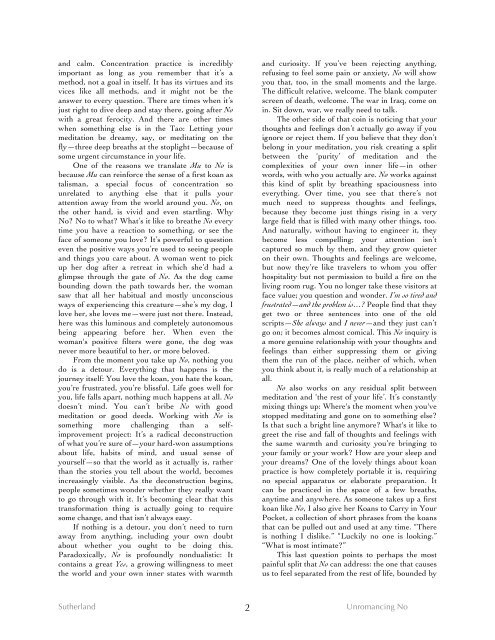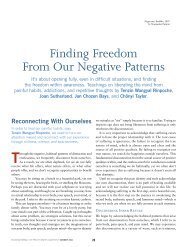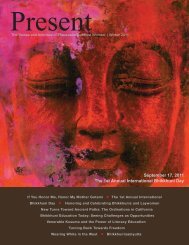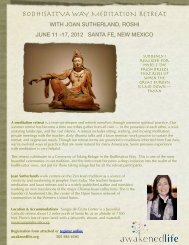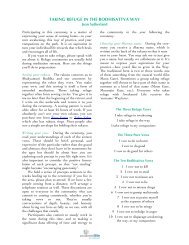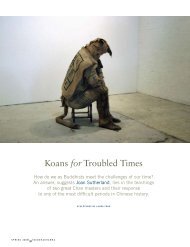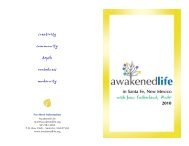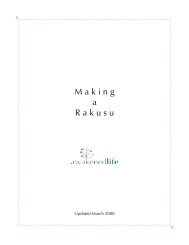Unromancing No Joan Sutherland - Awakened Life
Unromancing No Joan Sutherland - Awakened Life
Unromancing No Joan Sutherland - Awakened Life
Create successful ePaper yourself
Turn your PDF publications into a flip-book with our unique Google optimized e-Paper software.
and calm. Concentration practice is incredibly<br />
important as long as you remember that it’s a<br />
method, not a goal in itself. It has its virtues and its<br />
vices like all methods, and it might not be the<br />
answer to every question. There are times when it’s<br />
just right to dive deep and stay there, going after <strong>No</strong><br />
with a great ferocity. And there are other times<br />
when something else is in the Tao: Letting your<br />
meditation be dreamy, say, or meditating on the<br />
fly—three deep breaths at the stoplight—because of<br />
some urgent circumstance in your life.<br />
One of the reasons we translate Mu to <strong>No</strong> is<br />
because Mu can reinforce the sense of a first koan as<br />
talisman, a special focus of concentration so<br />
unrelated to anything else that it pulls your<br />
attention away from the world around you. <strong>No</strong>, on<br />
the other hand, is vivid and even startling. Why<br />
<strong>No</strong>? <strong>No</strong> to what? What’s it like to breathe <strong>No</strong> every<br />
time you have a reaction to something, or see the<br />
face of someone you love? It’s powerful to question<br />
even the positive ways you’re used to seeing people<br />
and things you care about. A woman went to pick<br />
up her dog after a retreat in which she’d had a<br />
glimpse through the gate of <strong>No</strong>. As the dog came<br />
bounding down the path towards her, the woman<br />
saw that all her habitual and mostly unconscious<br />
ways of experiencing this creature—she’s my dog, I<br />
love her, she loves me—were just not there. Instead,<br />
here was this luminous and completely autonomous<br />
being appearing before her. When even the<br />
woman's positive filters were gone, the dog was<br />
never more beautiful to her, or more beloved.<br />
From the moment you take up <strong>No</strong>, nothing you<br />
do is a detour. Everything that happens is the<br />
journey itself: You love the koan, you hate the koan,<br />
you’re frustrated, you’re blissful. <strong>Life</strong> goes well for<br />
you, life falls apart, nothing much happens at all. <strong>No</strong><br />
doesn’t mind. You can’t bribe <strong>No</strong> with good<br />
meditation or good deeds. Working with <strong>No</strong> is<br />
something more challenging than a selfimprovement<br />
project: It’s a radical deconstruction<br />
of what you’re sure of—your hard-won assumptions<br />
about life, habits of mind, and usual sense of<br />
yourself—so that the world as it actually is, rather<br />
than the stories you tell about the world, becomes<br />
increasingly visible. As the deconstruction begins,<br />
people sometimes wonder whether they really want<br />
to go through with it. It’s becoming clear that this<br />
transformation thing is actually going to require<br />
some change, and that isn’t always easy.<br />
If nothing is a detour, you don’t need to turn<br />
away from anything, including your own doubt<br />
about whether you ought to be doing this.<br />
Paradoxically, <strong>No</strong> is profoundly nondualistic: It<br />
contains a great Yes, a growing willingness to meet<br />
the world and your own inner states with warmth<br />
and curiosity. If you’ve been rejecting anything,<br />
refusing to feel some pain or anxiety, <strong>No</strong> will show<br />
you that, too, in the small moments and the large.<br />
The difficult relative, welcome. The blank computer<br />
screen of death, welcome. The war in Iraq, come on<br />
in. Sit down, war, we really need to talk.<br />
The other side of that coin is noticing that your<br />
thoughts and feelings don’t actually go away if you<br />
ignore or reject them. If you believe that they don’t<br />
belong in your meditation, you risk creating a split<br />
between the ‘purity’ of meditation and the<br />
complexities of your own inner life—in other<br />
words, with who you actually are. <strong>No</strong> works against<br />
this kind of split by breathing spaciousness into<br />
everything. Over time, you see that there’s not<br />
much need to suppress thoughts and feelings,<br />
because they become just things rising in a very<br />
large field that is filled with many other things, too.<br />
And naturally, without having to engineer it, they<br />
become less compelling; your attention isn’t<br />
captured so much by them, and they grow quieter<br />
on their own. Thoughts and feelings are welcome,<br />
but now they’re like travelers to whom you offer<br />
hospitality but not permission to build a fire on the<br />
living room rug. You no longer take these visitors at<br />
face value; you question and wonder. I’m so tired and<br />
frustrated—and the problem is…? People find that they<br />
get two or three sentences into one of the old<br />
scripts—She always and I never—and they just can’t<br />
go on; it becomes almost comical. This <strong>No</strong> inquiry is<br />
a more genuine relationship with your thoughts and<br />
feelings than either suppressing them or giving<br />
them the run of the place, neither of which, when<br />
you think about it, is really much of a relationship at<br />
all.<br />
<strong>No</strong> also works on any residual split between<br />
meditation and ‘the rest of your life’. It’s constantly<br />
mixing things up: Where's the moment when you've<br />
stopped meditating and gone on to something else?<br />
Is that such a bright line anymore? What's it like to<br />
greet the rise and fall of thoughts and feelings with<br />
the same warmth and curiosity you’re bringing to<br />
your family or your work? How are your sleep and<br />
your dreams? One of the lovely things about koan<br />
practice is how completely portable it is, requiring<br />
no special apparatus or elaborate preparation. It<br />
can be practiced in the space of a few breaths,<br />
anytime and anywhere. As someone takes up a first<br />
koan like <strong>No</strong>, I also give her Koans to Carry in Your<br />
Pocket, a collection of short phrases from the koans<br />
that can be pulled out and used at any time. “There<br />
is nothing I dislike.” “Luckily no one is looking.”<br />
“What is most intimate?”<br />
This last question points to perhaps the most<br />
painful split that <strong>No</strong> can address: the one that causes<br />
us to feel separated from the rest of life, bounded by<br />
<strong>Sutherland</strong><br />
2<br />
<strong>Unromancing</strong> <strong>No</strong>


